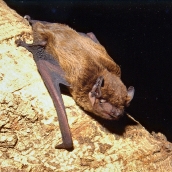Leisler’s Bat (Nyctalus leisleri)
A medium-sized bat with a forearm length of 38-47.1 mm. This bat is dorsally golden brown, though tones may vary, and ventrally paler. Its ears are short and broad, with a short tragus, and it has prominent glands on either side of the snout. In Macaronesia it is present in Madeira (subspecies N. l. verrucosus, endemic to the archipelago) and the Canaries (subspecies N. l. leisleri, also found in Northwest Africa, Europe and Asia), where it only lives in Tenerife and La Palma, but is a vagrant visitor to Lanzarote. N. azoreum is a well-differentiated species, exclusive to the Azores, and is found in a wide diversity of habitats (cliffs, lowland Euphorbia communities, mid-altitude farmland, urban centres, evergreen and pine forests, and high montane scrub) from near sea level to 2,150 m in the Canaries and up to 1,860 m in Madeira. Known roosts in Macaronesia are located in derelict buildings, nest-boxes for insectivorous birds, tree hollows and crevices. It often takes advantage of public street lighting to hunt small- and medium-sized insects, such as lepidoptera of the family Noctuidae. Very little is known about the biology of this bat, but breeding extends from September to October, when males experience greater testicular growth and exhibit territorial behaviour, and females suckle their young in May and June. Moreover, this is one of the few Canary Island species that hibernates above 2,000 m, at least in Tenerife, although it does remain active in winter but at mid-altitude and lower elevations. Despite being common and widely distributed in Madeira and Tenerife, and to a lesser extent in La Palma (the eastern sector of the island), this bat is under threat from several quarters, including roost disturbance and loss, and the use of chemical products in agriculture; a negative impact from wind parks, at least in Madeira, cannot be ruled out.













